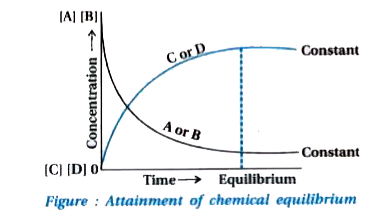Explain chemical equilibrium by giving example of general reaction.
Text Solution
Analogous to the physical systems chemical reactions also attain a state of equilibrium. These reactions can occur both in forward and backward directions. When the rates of the forward and reverse reactions become equal, the concentrations of the reactants and the products remain constant. This is the stage of chemical equilibrium.
Chemical equilibrium is .dynamic. in nature, it consists of a forward reaction in which the reactants give products and reverse reaction in which products gives the original reactants.
Let we take a normal reversible reaction...
A+B ⇔ C+D ...(i)
At the beginning the solubility of A and B is more and with passage of time, there is accumulation of the products C and D and depletion of the reactants A and B. (See Figure)

So, this leads to a decrease in the rate of forward reaction and an increase in he rate of the reverse reaction. After some time, the two reactions occur at the same rate , and the system reaches a state of equilibrium .
We can get equilibrium starting the reaction from any of the direction. We can also get equilibrium starting from C and D.
|
Topper's Solved these Questions
- EQUILIBRIUMBOOK - KUMAR PRAKASHANCHAPTER - EQUILIBRIUMEXERCISE - SECTION-A Try Your self -2
6 Videos
- EQUILIBRIUMBOOK - KUMAR PRAKASHANCHAPTER - EQUILIBRIUMEXERCISE - SECTION-A Try Your self -3
10 Videos
- ENVIRONMENT CHEMISTRY BOOK - KUMAR PRAKASHANCHAPTER - ENVIRONMENT CHEMISTRY EXERCISE - Question For Module (Section-C)
1 Videos
- HYDROCARBONSBOOK - KUMAR PRAKASHANCHAPTER - HYDROCARBONSEXERCISE - (Questions for Module (Section - D))
1 Videos
Similar Questions
Knowledge Check
A chemical reaction is in equilibrium when
Aformation of product is minimumBreactants are completely transformed into productsCrates of forard and backward reactions are equalDequal amounts of reactants and products are present.A chemical reaction is at equilibrium when
A(A) Reactants are completely transformed into productsB(B) The rates of forward and backward reactions are equalC(C) Formation of products is minimisedD(D) Equal amounts of reactants and products are presentA chemical reaction is at equilibrium when
AReactants are completely transformed into productsBThe rates of forward and backward reactions are equalCFormation of products is minimisedDEqual amounts of reactants and products are present
Explain the following :
(i) A chemical equilibrium is of dynamic nature.
(ii) In a reversible reaction , equilibrium can be achieved from either sides.
(iii) Equilibrium is generally attained in reaction carried in close containers.
View SolutionA chemical reaction is at equilibrium when
View SolutionDoes a chemical reaction become static when equilibrium is reached ? Comment and explain.
View SolutionGive one example of a chemical reaction involving homogeneous catalyst.
View SolutionIf a chemical reaction is at equilibrium, it means that
View Solution
